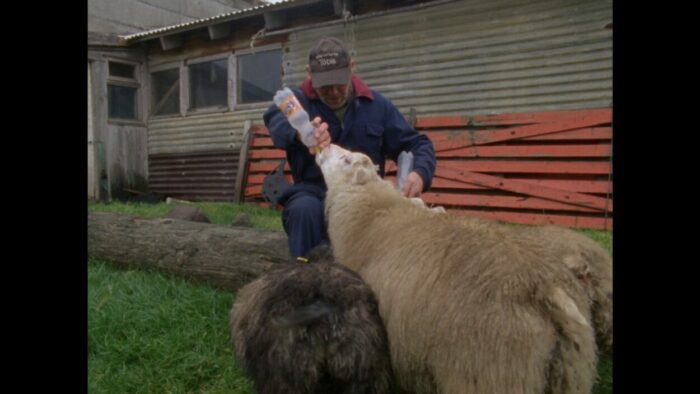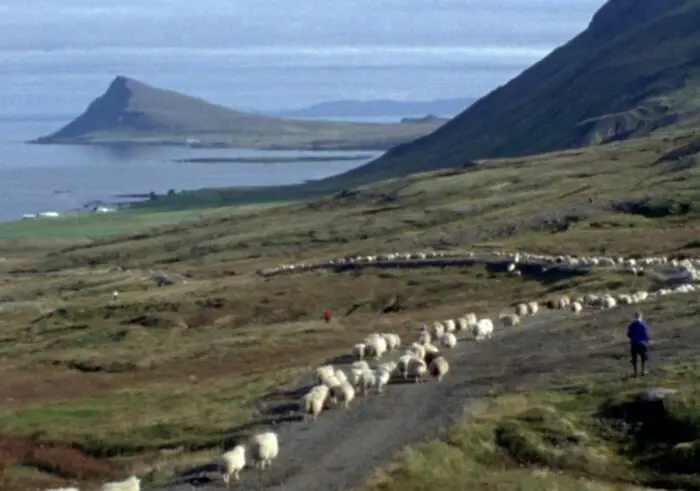Árneshreppur, Iceland, is the country’s smallest parish. There, centuries ago, where its remote hillsides butted up against the Arctic Ocean, its first settlers lived, largely without contact with the outside world, a life of quiet harmony with their livestock and the harsh nature of the inhospitable land. Since the settlement, the land has been home to generations of farmers who’ve had only occasional contact with the outside world. It’s a way of life soon to pass forever as the settlement’s last inhabitants, its living legacy, ready themselves to make a fateful decision in The Last Autumn.
A documentary equal parts observational and poetic, The Last Autumn, following its official selection at film festivals around the world, arrives this month on North American VOD and digital courtesy of Film Movement. Directed by Yrsa Roca Fannberg, the film features its two primary subjects, Úlfar and Oddny, a gently aging Icelandic couple whose life has always followed the cyclical nature of farm work. Yet with each successive autumn, the work becomes more demanding and less rewarding.
For centuries, the Icelanders taught their young the means of breeding and herding sheep. But Úlfar and Oddny’s children and grandchildren have moved on to urban life elsewhere, returning only when necessary to assist in the seasonal sheep herding. Fannberg, who with her watchful camera, came to assist each year and embedded herself with the family in 2016, when the bulk of The Last Autumn was shot. Falling in love with the harsh beauty of the land and the integrity of the farmers, she focused her lens on their “last autumn”: the family’s final descent from the surrounding hills with their flock. Their family scattered, their farming no longer sustainable, Úlfar and Oddny growing older, the family have come to the end of an era.
The village of Árneshreppur is so small that in 2016, there were just nine farms and five children in the local school; the village itself consisted of nothing more than these and a small shop. Today, the shop and school are closed, the children gone. Farming has long been the cornerstone of life in Árneshreppur, but with the younger generations having moved away, there is, for Úlfar and Oddny, no longer anyone to farm for. Their herd, a few dozen sheep, have little value if no one nearby exists to purchase their wool.

Aside from some blissfully, movingly poetic exchanges at the start of the film and again at its end—not to mention one suspenseful sequence in its middle—The Last Autumn works in the vein of traditionally observational cinema. There are no interviews, no graphics, no lower-thirds chyrons explaining the visuals, and no voice-over narration of any kind. There is, simply, Fannberg observing with her cinematographer Carlos Vasquez Mendez the couple at work and at rest, tracing the rhythms of chores and eavesdropping on conversations both incidental and fateful. At times, the camera will remain static for a minute or more as Úlfar, Oddny, and their visitors wander into and out of the frame, a technique reinforcing the fact that even when the Icelandic people have left, the land will remain.
The film opens with a poetic, imagistic sequence that may have you wondering if you’ve stumbled upon a long-lost sequence from a forgotten Ingmar Bergman film. A fine-grain, high-contrast black-and-white slow montage of images of the land is accompanied by a sonorous voice-over quoting Nordic myth, the genesis preceded by Ragnarök emphasizing the circularity of time and the perpetuity of the land. It looks and feels a bit like the opening of The Seventh Seal. When the film turns to the present day, it does so in color, but in a muted palette emphasizing the challenge of the terrain and its impact on those who live there.

In another sequence, Úlfar and others race the flock down the hill as the non-diegetic music throbs and pulses like a modern arthouse horror film. Will this physical challenge be the aging farmer’s last? Elsewhere, though, Fannberg’s documentary is a model of a quiet economy that suits its subject perfectly, capturing the difficult decisions the couple must make. If no one has need of the flock’s wool, what value does it have? Viewers sensitive to harm depicted to animals should be prepared for the consequence of the farmer’s decisions. Suffice it to say that they are not bloodless. The Last Autumn is unsparing in examining the harsh realities of a live lived on—and off—the land and its creatures.
The Last Autumn is, in that way, that rare work of documentary art that can both instruct and engage, like last year’s Children of the Mist or House Made of Splinters, following its subject closely, empathetically, and honestly, even when they face moments of change and crisis, finding beauty and insight in the everyday and the real.
The Last Autumn, directed by Yrsa Roca Fannberg and produced by Akkeri Films, arrives on North American VOD and digital platforms June 30, 2023, courtesy of Film Movement Plus. 78 minutes, in color and black and white. In Icelandic with English subtitles.




